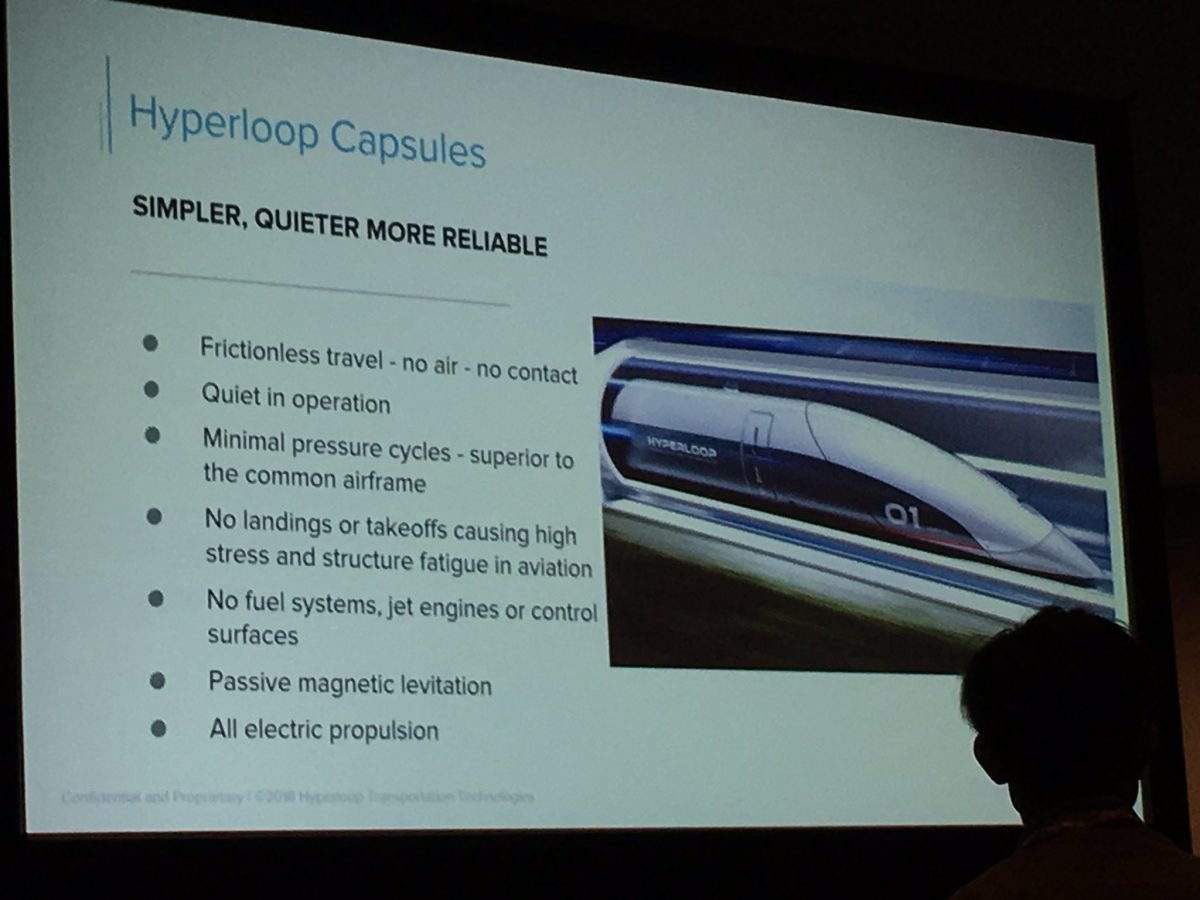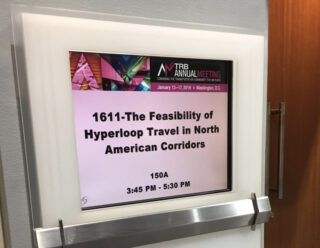Welcome to the latest dispatch from our Transportation Research Board Annual Meeting Special Correspondent Aaron Brown, who’s in D.C. covering this event thanks to a funding partnership with the Transportation Research and Education Center at Portland State University (TREC at PSU). See past coverage here.
New Modes, New Research, New Challenges, New Opportunities
As TRB gears up to celebrate its centennial (a detail that conference organizers are eager to mention as many times as possible), it’s hard not to pick up the infectious enthusiasm and energy surrounding the exciting new fields of academic research and inquiry. As recently as a decade or two ago, academic inquiry on bicycles as transportation options were limited to a handful of specific universities across the country. Now, virtually every up-and-coming transportation planning student is well-versed (and frequently seeking a career in) active transportation, and the role it plays in designing communities.
TREC at PSU at TRB
In some ways, the bicycle and pedestrian advocates are being usurped (if not in size, then certainly in sexy PR and attention) by the significant boom in new forms of urban micromobility (and a fastidiously curious army of graduate students interested in studying their implementation). Representatives from all the major e-scooter companies are here, and numerous studies are focused on how scooters, bike share systems (dockless or otherwise), and e-bikes (sharable or otherwise) are exploding in popularity in small, but growing niche communities. The studies undertaken by these modes – who rides them, in what conditions, at what costs, at what benefits, for what purposes – are being rolled out at a pace only limited by the rate at which they are rolled out to the public. I saw research today showing how e-bikes in a bikeshare fleet in Utah were used, how bike trailers in German cities were ideal for cargo delivery, and how scooters were solving “last-mile” problems of connecting people to transit stations in low-density suburban sprawl.
The timing is fortuitous, considering PBOT rolled out their statistical findings from the scooter pilot yesterday. The new innovations in micromobility are going to provide a whirlwind of options for people to easily travel 1-2 miles, if municipal governance is generous enough with the road space. As Portland and its suburbs continue to densify (which seems likely, with the slate of YIMBY housing legislation on deck in Salem and Portland’s Residential Infill Project in line), all of the research is suggesting the new technology represents a widespread democratization of the 1-2 mile trip. Making it easier for larger swaths of the public to feel comfortable and invited to not drive for a short trip – dropping off a library book, getting to the transit center, picking up groceries – is only going to grow the latent desire for walkable, dense communities that are, conveniently, also perfect for bicycling.
In short: please, please BikePortland readers: let’s welcome back the scooters with open arms. Make fun of them all you want; but every person on a scooter is a potential partner in our rabble-rousing for a Portland with less motordom and more options for low-carbon, healthy communities.
Data (But for Who?)
There’s another major trend underway that has spurred a blossoming of new transportation research. Every Biketown ride, every Lyft/Uber, every e-scooter is collecting an enormous amount of data. The crew of engineers and urban planners who attend TRB are finding all sorts of way to put this mountain of numbers to use – mapping them, modelling them, running regression analyses, finding correlations and so on. Enormous datasets like these are catnip for the planners and researchers trained in a pedagogy that heavily prioritizes quantitative analysis.
The University of Oregon’s Anne Brown (no familial relation, although full disclosure, we had classes together in college) conducted award-winning research on Lyft’s travel data. She was granted access to a data set of Lyft travel patterns in Los Angeles, and was able to determine all sorts of interesting facts about the role that Lyft was playing in filling mobility gaps in automobile-oriented Los Angeles (check out her website to learn more about her findings).
The tricky problem, though, is that all of these ride-hailing services are notoriously fickle about sharing their information. This came up repeatedly in sessions today and yesterday – urban planners and researchers politely agreed that autonomous vehicles have the capacity to positively reshape american cities, but the fiercely guarded proprietary information held by these TNCs obstruct the ability for policymakers to appropriately plan for their arrival.
There are privacy concerns about this sort of data that need to be addressed, and there’s a case to be made that Lyft and Uber make their money on the closely guarded secrets hidden inside the data and therefore the government shouldn’t be prying into the numbers. But with the “AUTONOMOUS VEHICLES ARE COMING TO RESHAPE OUR CITIES” boosterism breathlessly championed and upheld by significant venture capital funding, it seems abundantly clear from the presentations I’ve seen today that the dearth of publicly available data on ride-sharing represents a challenge towards ensuring public sector entities can defend the public’s right to the street from all-too-eager-to-monopolize the right-of-way.
I Am Skeptical of the Hyperloop

In the interest of bemused self-flagellation, I stepped in to the second half of a presentation titled, “The Feasibility of Hyperloop Travel in North American Corridors”. To my surprise, the room was packed, with at least 120 people intently listening to four presentations with fancy graphics and futuristic designs explaining how hyperloop systems could immediately be built to connect Chicago to various far-flung cities across the midwest in under an hour or two. I suppose it’s entirely defensible to be lured in by the promise of a Jetsons-esque vision of people shooting about the country at seven hundred miles an hour in pneumatic tubes, and I don’t begrudge anyone for sparing a moment to daydream about some radically fantastic new infrastructure plans (if I did, I’d have to hide all those fantasy transit maps I’ve drawn up over the years).
At the end of the day, however, somehow, not-insignificant amounts of money are being peddled around between various consulting firms and business leaders showing up in destitute midwestern towns and promoting completely unproven, expensive technology at a time in which we can’t even fund potholes on our existing roads.
Bicycles and trains were invented in the 19th century, and while we’ve certainly improved on them in plenty of ways, the technology itself is still readily available and evidently effective at providing meaningful, scalable investments in mobility both at a national scale and at an urban scale. Forget that the idea the federal government will somehow manage to find a way to acquire the endless miles of land necessary to build these facilities, or that doing so won’t be an endless mess of litigation – is the problem with American transportation really that one can’t get to Chicago from Cleveland in under an hour? Or is it that doing so without an automobile is horrifically inconvenient, infrequent, and delayed? That Cleveland’s municipal bus system is underfunded and de-prioritized, that traffic fatalities are depressingly concentrated in low-income neighborhoods of each of these communities? What problems are we actually trying to solve, here, and what problems are only going to be exacerbated by building a gajillion dollar pneumatic tube? Whose rapid speed and movement (let alone safety) are we prioritizing, and whose are stuck waiting for some curb cuts and crosswalks?
OK. That’s all I can muster. Off to a gathering of our friends from TREC at PSU! Stay tuned.
— Aaron Brown, @ambrown on Twitter.
Never miss a story. Sign-up for the daily BP Headlines email.
BikePortland needs your support.
The post TRB dispatch: Micromobility, big data, and hyperloops appeared first on BikePortland.org.
from BikePortland.org http://bit.ly/2HosX7Y



No comments:
Post a Comment